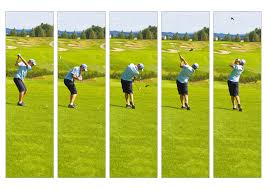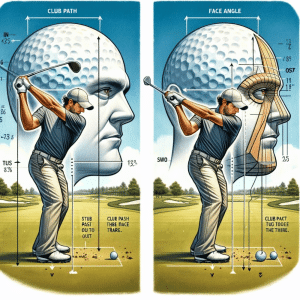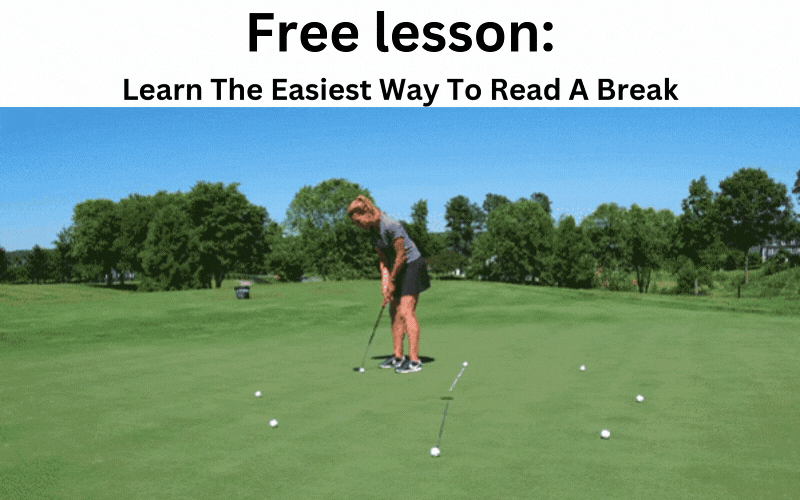Introduction
Welcome to our comprehensive guide on mastering one-plane golf swing mechanics.
In this article, we'll delve into the fundamentals, mechanics, and common mistakes associated with the one-plane golf swing.
Whether you're new to golf or looking to refine your swing, this guide will equip you with the knowledge to elevate your game.
So, grab your club, and let's take a swing at understanding the one-plane golf swing mechanics.

Understanding the One-Plane Golf Swing
What is a One Plane Golf Swing?
A one-plane golf swing is a technique in which the golfer swings the club on a single swing plane, typically on or around the shoulder plane.
This technique is characterized by the alignment of the club and the lead arm on the backswing, creating a single plane throughout the swing.
When executing a one-plane golf swing, the club does not deviate from the established plane, resulting in a more compact and connected motion.
This method is often associated with certain golfers' preference for rhythm and timing over power, making it a popular choice among players who seek consistency and accuracy.
- Address Position: The starting position of the body and club before initiating the swing.
- Backswing: The movement of the club and body away from the target in preparation for the downswing.
- Downswing: The motion of the club and body returning towards the ball to make contact.
- Follow Through: The completion of the swing after contact with the ball.
A well-executed one-plane golf swing offers several advantages:
- Consistency: The single plane minimizes variations, leading to consistent ball striking.
- Improved Timing: The connected motion enhances the golfer's timing and rhythm, contributing to better control over the swing.
- Reduced Tension: The lack of abrupt shifts in the swing reduces tension, promoting a smoother and more effortless swing.
Key Differences Between One-Plane and Two-Plane Swing
In the context of golf swings, the distinction between a one-plane and a two-plane swing is fundamental to understanding the mechanics and dynamics of the game.
Both swings have their unique characteristics, and each approach offers different advantages and challenges to golfers.
Let's delve deeper into the key differences between the one-plane and two plane swings:
- Swing Plane: The one-plane swing follows a flatter swing plane, which means the club shaft and the shoulders align on the same angle. In contrast, the two-plane swing involves a steeper downswing that sets the club on a different plane than the shoulders.
- Body Movement: With the one-plane swing, the body's movements are more rotational, leading to a smoother and connected swing motion. In the two-plane swing, there's a noticeable separation between upper-body and lower-body movements, resulting in a more segmented swing.
- Power vs. Control: The one-plane swing is often associated with generating power and distance, making it suitable for golfers looking to maximize their driving potential. On the other hand, the two-plane swing emphasizes control and precision, offering advantages in shaping shots and achieving more accuracy.
- Consistency: One key difference lies in the consistency of ball striking. The one-plane swing promotes a more consistent impact location with the clubface, contributing to better ball striking. In the two-plane swing, due to the nature of the swing, achieving consistent impact can be more challenging.
- Adaptation: Golfers have different preferences and physical attributes. The one-plane swing tends to accommodate golfers with more flexibility and athleticism, while the two-plane swing may suit golfers with more structured and methodical approaches to the game.
Benefits of One Plane Golf Swing
The one-plane golf swing offers several advantages that can improve a golfer's performance and overall experience on the course.
Here are some key benefits of using a one-plane golf swing:
- Consistency: The one-plane swing promotes a more consistent ball strike due to its unified and streamlined motion.
- Simplicity: It simplifies the swing motion, making it easier for golfers to maintain a repeatable and reliable technique.
- Power: By maximizing the body's rotation and leverage, the one-plane swing can generate impressive power and distance.
Mastering the Mechanics
Swing Plane and Its Importance
The swing plane is one of the most crucial aspects of a golfer's technique, and understanding its importance can significantly impact performance on the course.
Let's delve deeper into the significance of the swing plane and how it affects the overall mechanics of the golf swing.
- Understanding Swing Plane: The swing plane refers to the imaginary plane in which the golf club travels during the swing. It plays a vital role in determining the accuracy, distance, and consistency of the shots.
- Impact on Ball Flight: A proper swing plane directly influences the direction and trajectory of the golf ball. It affects whether the ball will draw, fade, slice, or hook.
- Body Position and Movement: The swing plane is closely linked to the golfer's body position and movement. It dictates the correct alignment and motion required for a successful swing.
Exploring the ideal swing plane for different clubs and the adjustments needed based on the specific shot requirements can greatly enhance a golfer's game.
Proper drills and exercises focused on mastering the swing plane are essential for refining one's skills and achieving consistency on the golf course.
Proper Body Alignment
Proper body alignment is crucial for a golfer's swing.
It directly impacts the consistency and accuracy of their shots.
Here's a detailed look at the key aspects of body alignment:
- Feet Position: The feet should be shoulder-width apart with the toes slightly flared out. This provides a stable base for the swing.
- Hip Alignment: The hips should be parallel to the target line. This ensures that the body rotation during the swing is smooth and coordinated.
- Shoulder Alignment: Proper shoulder alignment helps maintain the desired swing plane and promotes a square clubface at impact.
- Spine Angle: The spine should be tilted slightly away from the target, creating the ideal posture for powerful and consistent ball striking.
Additionally, it's important to note that correct body alignment is not just about aligning the body parts; it also involves positioning the body about the target and the swing plane.
When a golfer achieves proper body alignment, they are better equipped to execute their swing with precision and confidence.
Club Path and Face Angle

When it comes to achieving a controlled and consistent golf swing, the club path and face angle play a crucial role.
Understanding these elements is essential for optimizing ball flight and improving overall performance on the course.
Let's delve deeper into the dynamics of club path and face angle to gain a comprehensive understanding:
- Club Path: The club path refers to the direction the clubhead is traveling through impact. It can be classified as either in-to-out, out-to-in, or straight. Each club path has its effect on the direction and shape of the shot.
- Face Angle: The face angle pertains to the orientation of the clubface at impact. The angle can influence the initial launch direction and shot shape. The face angle can be open, closed, or square at impact.
Here are some key points to consider for improving club path and face angle:
- Practice with alignment rods to visualize and correct the club path during the swing.
- Utilize impact stickers or spray to monitor the face angle at impact and make necessary adjustments.
- Understand how club path and face angle affect ball flight and work on optimizing these factors to achieve desired shot outcomes.
By honing the club path and face angle, golfers can enhance control over their shots and consistently produce the desired ball flight.
Basic One Plane Swing Drills
Mastering the one-plane swing requires dedication and consistent practice. Here are some essential drills to help you improve your technique:
- Alignment Drill: Use alignment rods or clubs to ensure that your body, club, and target are properly aligned. This drill helps you understand the correct positioning for a one-plane swing.
- Shoulder Turn Drill: Focus on making a full shoulder turn while keeping your lower body stable. This drill promotes the proper coiling of the upper body, essential for a one-plane swing.
- Takeaway Drill: Practice a smooth and controlled takeaway, ensuring that the club stays on the correct plane. Emphasize the one-piece movement of the arms, hands, and shoulders.
- Downswing Sequence Drill: Work on the proper sequencing of the downswing, initiating the movement from the lower body and allowing the arms to drop naturally into the slot on the correct path.
Common Mistakes to Avoid
Over-The-Top Swing
An over-the-top swing is a common mistake that many golfers make, leading to poor shot accuracy and distance.
It occurs when the golfer's club moves outside the target line on the downswing, resulting in an out-to-in swing path.
This faulty movement can cause slices, pulls, and inconsistent ball striking.
To correct an over-the-top swing, golfers should focus on:
- Starting the downswing with the lower body, initiating the movement from the hips and legs rather than the upper body.
- Practicing with an alignment rod placed just outside the ball-target line to develop a proper swing path.
- Ensuring a smooth transition from the backswing to the downswing, maintaining a consistent swing plane.
Improper Weight Shift
One of the most common mistakes in golf swing is the improper weight shift.
This occurs when the golfer fails to transfer their weight effectively between the back and forward swing.
It can significantly impact the accuracy and power of the shot. Proper weight shift is crucial for a balanced and controlled swing.
Key Factors:
- Understanding weight transfer from backswing to downswing.
- Importance of lower body movement in weight shift.
- Effects of improper weight shift on shot trajectory.
Lack of Wrist Hinge
One common mistake that many golfers make is the lack of proper wrist hinge in their swing.
This is a crucial element in executing a powerful and accurate golf shot.
Without the right wrist hinge, golfers may struggle to generate the necessary clubhead speed and may experience inconsistent ball striking.
- Loss of Power: Proper wrist hinge allows for the storage and release of energy, resulting in greater clubhead speed and distance.
- Accuracy Issues: Without a good wrist hinge, golfers may find it challenging to maintain control over the clubface, leading to errant shots.
- Increased Risk of Injury: Inadequate wrist hinge can put a strain on other parts of the body, leading to potential injury.
To overcome the lack of wrist hinge, golfers should focus on proper wrist sets during the backswing and maintaining the angle during the downswing.
It is essential to practice wrist hinge drills to improve this aspect of the swing and ensure optimal performance on the course.
Developing Consistency and Accuracy
Importance of Rhythm and Tempo
Rhythm and tempo play a crucial role in the success of a golfer.
Understanding and mastering these concepts can significantly enhance a player's performance on the course.
- Enhanced Consistency: Developing a consistent rhythm and tempo in the swing leads to more predictable ball striking and shot outcomes.
- Improved Timing: Proper rhythm and tempo contribute to better timing, allowing the golfer to synchronize body movements for optimal club impact.
- Mental Focus: Establishing a steady rhythm and tempo can promote mental focus and prevent rushing, leading to more controlled and composed play.
Examples of golfers who have mastered rhythm and tempo, such as Rory McIlroy and Lydia Ko, showcase the significant impact of these elements on their gameplay.
Practice Strategies for Improvement
Improving your golf game requires strategic and focused practice.
Here are some effective practice strategies to help you enhance your skills:
- Visualization Techniques: Mental imagery of a perfect swing can help reinforce muscle memory and improve technique.
- Structured Drills: Incorporate exercises that target specific aspects of your game, such as putting, chipping, and driving.
- Progressive Challenges: Set incremental goals to push your limits and measure your improvement over time.
- On-Course Simulation: Practice as if you are in a real game situation to develop strategic thinking and course management skills.
Mental Approach to One Plane Swing
The mental approach to the one-plane swing is crucial for golfers looking to improve their game.
Here are some key factors to consider:
- Visualization: Visualizing a smooth and seamless one-plane swing can help golfers develop muscle memory and consistency in their strokes. Mentally rehearsing the swing can instill confidence and composure on the course.
- Focus and Concentration: Maintaining focus on the swing plane and having unwavering concentration during the backswing and downswing is essential for executing a one-plane swing effectively.
- Positive Mindset: Adopting an optimistic mindset can significantly impact a golfer's performance. Believing in the one-plane swing technique and trusting the process is key to success.
- Breathing Techniques: Implementing controlled breathing techniques can help golfers stay relaxed and composed throughout the swing, leading to better execution of the one-plane swing.
- Mental Rehearsal: By mentally rehearsing the one-plane swing off the course, golfers can reinforce the correct movements and sequence, resulting in improved performance during actual gameplay.
One Plane Golf Swing Mechanics Conclusion
Equipped with a deeper understanding of the one-plane golf swing mechanics, you're poised to elevate your game and unlock the potential for greater precision and power on the course.
Embrace the fundamental principles, remedy common mistakes, and dedicate focused effort to develop consistency and accuracy in your one-plane swing.
As you embark on this journey, remember that mastery comes with patience, practice, and a genuine passion for the game.
Here's to more confident and rewarding swings on the fairway!
